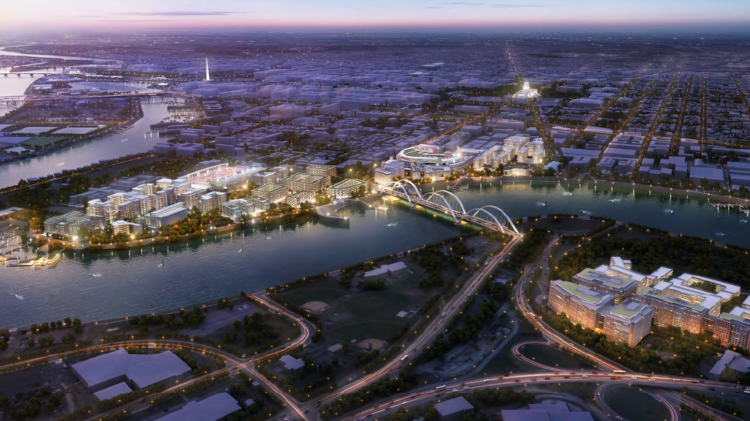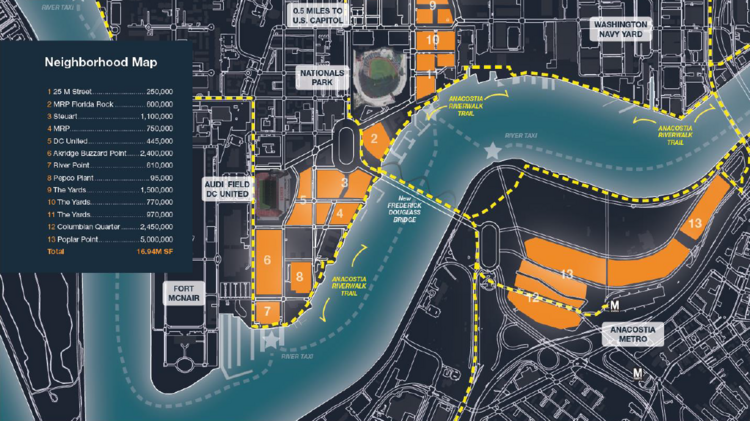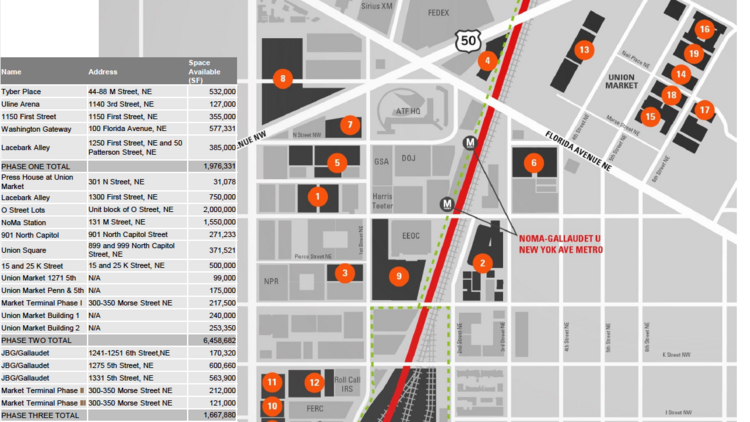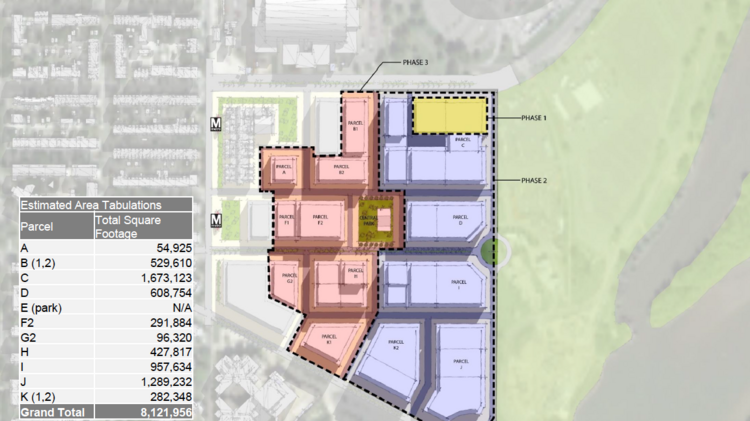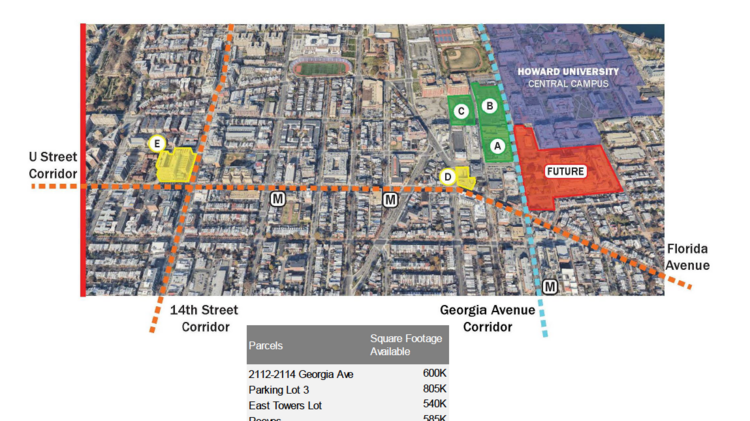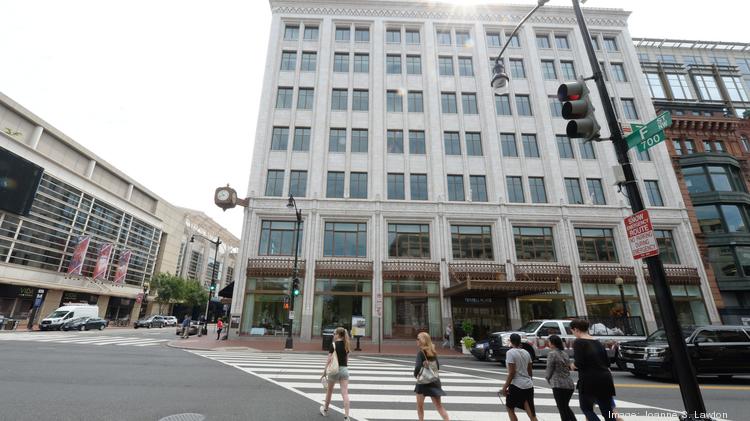Brian Kenner, D.C.'s deputy mayor for planning and economic development, said the prospective sites meet Amazon's space needs and then some, offering the kind of atmosphere and amenity base that will help it attract and retain top talent while checking off the boxes Amazon set in its request for proposals.
"While people may focus on the real estate in particular, I think there's lots of other things that Amazon is asking for in their solicitation and I think that, as we've said before, we feel like this is coming at the perfect time for Washington, D.C.," Kenner said. "We're a growing city. We've proven that we can attract world-class tech and innovation companies before."
The Seattle-based online retailer and cloud computing company has set some steep requirements for what it's calling HQ2, with an initial 500,000 square feet or more come 2019 and up to 8 million over time. Interested bidders have until Thursday to submit their proposals, and several prospective sites across Greater Washington have already surfaced including the Center for Innovative Technology site in Fairfax and Loudoun counties. Amazon expects to make its final site selection in 2018.
The District began receiving pitches and suggestions soon after the prospect was announced, and DMPED put out an "all call" to developers and other interested parties by the end of that week with responses due the following Wednesday.
After weeding out sites that were either too small, such as St. Elizabeths East at around 3 million square feet, or complicated by federal ownership or control, such as RFK Stadium and the FBI's current headquarters, the city has settled four — all large enough to meet Amazon's initial 2019 needs without any zoning changes or other major site development issues and are close to if not at by Metro station.
"We're going to be aggressive around this. We think the solicitation was written for us," Kenner said in an interview. "We think that we have world-class amenities. We have access to water. We have access to public transportation. We have access to world-class airports. We're located on the East Coast, and we are an East Coast hub."
Here's a look at the four areas DMPED has identified:
Anacostia riverfront: This prospect includes select properties near D.C. United's planned Buzzard Point soccer stadium in Southwest and at Forest City Washington's The Yards development by Nationals Park and part of Poplar Point across the Anacostia River not under the federal government's control — both in Southeast.
Assembling sites on Buzzard Point, by the Navy Yard-Ballpark Metro and Poplar Point by… more
Fresh off the opening of The Wharf's first phase, Kenner said offering waterfront views like those on Buzzard Point should be an added amenity for the Seattle-based company. The sites in this assemblage are spread out but connected by a variety of means including Metro, water taxi and the planned Frederick Douglass Memorial Bridge replacement. There's also the proximity to Nats Park and Audi Field as an added amenities for Amazon employees.
The redevelopment of the U.S. Coast Guard's former headquarters in Buzzard Point, now planned as the residential-over-retail Riverpoint (the permits are already in for the demolition) could be reprogrammed to meet Amazon's 2019 needs, as could the planned office portion of The Yards. It could be a tough sell to convince Amazon to spread itself over three sections of the Anacostia riverfront, particularly with the third across the water in an area the District has so far struggled to gain much traction with.
NoMa-Union Station: Union Station's status as a major transportation hub is the anchor of this assemblage, with offshoots including the new shops and restaurants that have sprung up in the neighborhood north of Massachusetts Avenue, or NoMa, and all the activity surrounding Union Market. It would also put Amazon in close proximity to Gallaudet University and the potential collaboration that could take place with students there.
Union Station, in Northeast D.C., is primed for a major makeover and expansion in the years ahead, and Akridge has planned a major new development atop the rail station, Burnham Place, that could be incorporated into Amazon's long-term needs. Amtrak needs a significant amount of money to upgrade Union Station before Akridge can develop the space above it for Burnham Place, however, and it is not slated to complete the renovations it has planned until 2021.
Sites that could meet Amazon's near-term needs include Skanska USA Commercial Real Estate Development's Tyber Place, with about 532,000 square feet of planned office space, another 127,000 square feet in Douglas Development Corp.'s completed Uline Arena redevelopment, and MRP Realty's Washington Gateway at more than 577,300 square feet.
But locating an office user with up to 50,000 employees and 8 million square feet in NoMa might seem a tight fit for the area given how much is already there. NoMa alone is just about 60 percent of the way toward a total development capacity of around 36.6 million square feet, and Robin-Eve Jasper said she is confident developers and business owners in the area will come together to support Amazon's second headquarters should that location win out.
"It’s important, it’s significant, they would clearly put their print on the character of the neighborhood, but they wouldn’t overwhelm it," Jasper said. " I really see it as a net positive."
This assemblage is centered around Union Station as a major transit hub and captures the… more
Capitol Hill East: Of the four sites identified by DMPED, this one by RFK Stadium is the only one large enough for Amazon to create a second headquarters on a single campus without gaps in between. The site's development potential fits the company's maximum space needs with a buffer, and would give a boost to the District's larger efforts to spark a revitalization around the stadium D.C. United will soon shed for its new home.
The District has picked the team of Donatelli Development and Blue Skye Development to remake a small part of the 60-plus acre site, known as Reservation 13, though its piece would not be part of the footprint DMPED envisions for Amazon's second home. As with the Anacostia Riverfront, Kenner said, Hill East offers waterfront views, easy access to the Stadium-Armory Metro, and could potentially be folded into the longer-term plans for RFK.
"It's got transportation and water, which is one of the things we're selling in Washington, D.C.," Kenner said. "No matter who's looking at Washington, we are an urban location. We think this could be a great urban headquarters for Amazon."
One downside: Reservation 13 is home to the D.C. General homeless shelter, which Mayor Muriel Bowser has committed to close, a handful of other social service uses and the D.C. Jail, which may be replaced — or may not be. It is hard to imagine Amazon investing $5 billion in a second headquarters located adjacent to a prison.
This site by RFK Stadium and the Stadium-Armory Metro is the only one of four where… more
Shaw-Howard University: This site would come short of Amazon's 8 million-square-foot target, but it could offer more soft amenities such potential collaboration with Howard University, proximity to the District's 14th and U Street corridors and the tech scene that has emerged in the District's Shaw neighborhood.
Amazon could also help Howard reimagine its plans for a town center including the historic Bond Bread factory building at 2146 Georgia Ave. NW, the subject of a rebooted request for qualifications. In the longer term, it could also include working with Howard University Hospital on a redevelopment of its facilities there, but that wouldn't be part of any 2019 plan.
"It is also located in a very historically, culturally diverse area, but also an area that is very much neighborhood already," Kenner said. "It has a feel and a vibe, and we think that vibe might actually be attractive to Amazon."
At the same time, it's a stretch to include Shaw in this bid, as it's included only with the addition of the Reeves Center nearly a mile west of Howard's main campus. And getting to 6 million square feet is based on variables in terms of what future plans are for Howard's hospital.
This assemblage is the tightest of the four at only 6 million square feet, less than… more
Looking downfield: Amazon doesn't expect to hit the 8 million-square-foot mark until beyond 2027, leaving time to prep other sites such as Akridge's Burnham Place at Union Station. Having the real estate is only part of the equation, however. In announcing its intentions, Amazon also set off a bidding war among state and local governments pursuing the prospect. Several jurisdictions have hinted at their willingness to open their purse strings for the company, including Maryland's boast to offer the largest incentive package the Free State has ever offered.
Kenner said DMPED is approaching incentives for Amazon in the same performance-based manner it offered to The Advisory Board Co. and others, whereby companies must create jobs and meet other goals before they see the financial benefits. He noted the District already has incentives that don't need approval of the D.C. Council, such as the Qualified High Technology Companies program and its companion Creative and Open Spaces Modernization Amendment Act of 2015 that Blackboard and Yelp benefited from.
"LivingSocial's a great example of that, a company that said it was going to grow, ended up not growing, and therefore didn't get any money because they didn't grow," Kenner said. "We feel like we could put something together that would have similar elements and be very similar to that for Amazon."
Online reviewer Yelp Inc., which has signed a lease at Terrell Place across the street… more
Not a make-or-break-proposition: Landing Amazon would be a major coup for the District, but Kenner said not landing the tech company isn't something he would view as a blow to D.C.'s economic development prospects.
While several of the sites in contention would need to be reprogrammed for Amazon, such as Buzzard Point, Kenner said the four areas DMPED has identified will grow regardless and would be able to absorb Amazon without a major disruption to those plans.
"There's lots of other development potential that's going to occur in this area over 20, 30 years, and so we feel like there's not going to be a lot of cannibalization," Kenner said. "We don't have to completely turn on its head everything that has been planned already to make this option happen."
https://www.bizjournals.com/washington/news/2017/10/16/d-c-details-where-how-it-would-meet-amazons-steep.html?ana=e_wash_bn&u=iwiEv47oBIqiyqQDXcPElcFKjr4&t=1508166262&j=79000201



